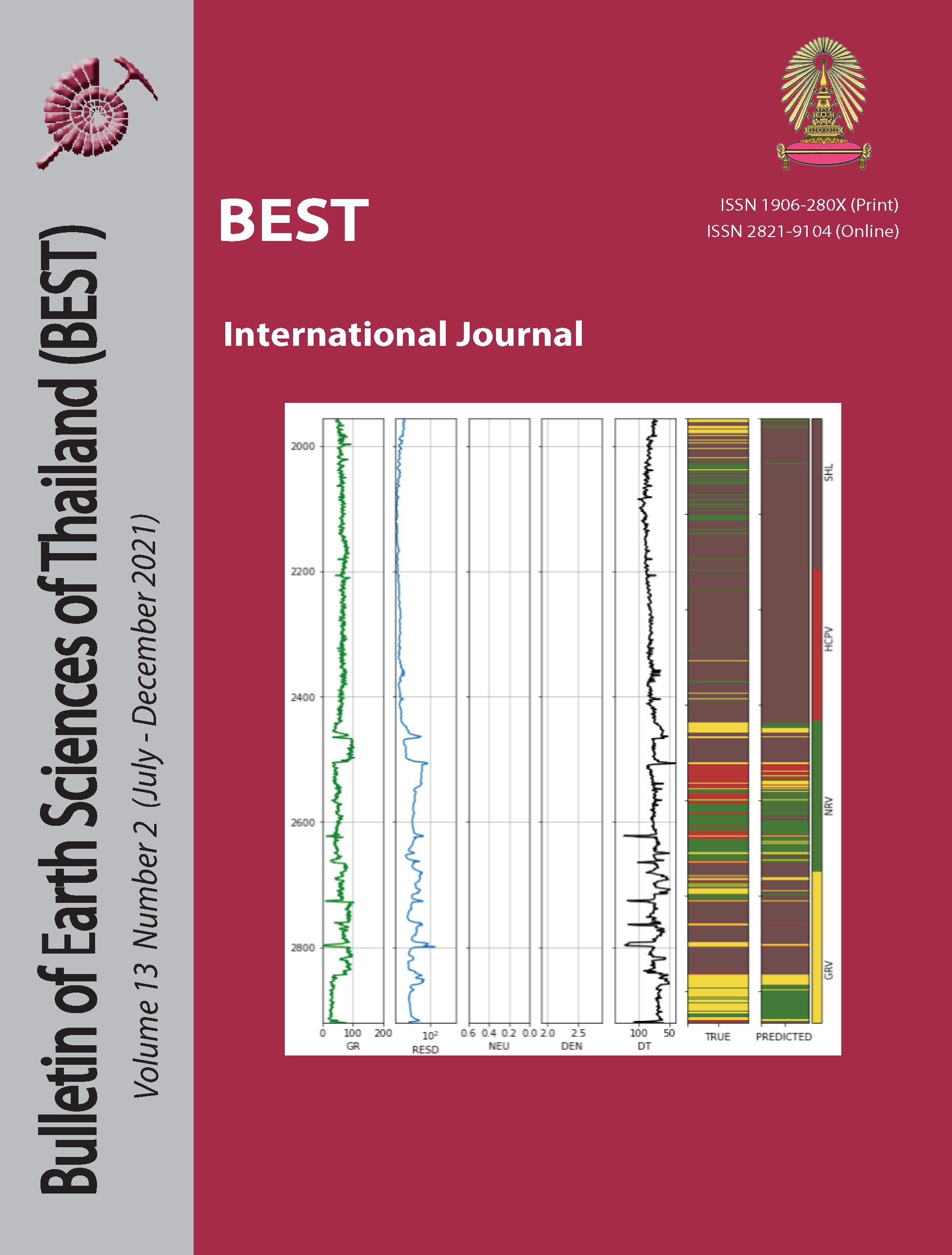Automatic machine learning (AutoML) for petrophysical evaluation: Case study in Sirikit Field Thailand
Main Article Content
Abstract
The petrophysical interpretation is critical for assessing the economic justification. However, the existing workflow of petrophysical assessment is time-consuming. This study aims to investigate the petrophysical interpretation utilizing the machine learning algorithms in the determination of lithology classification and reservoir identification from well log data of Sirikit field. This experiment is based on data from 50 deviated wells located throughout the Sirikit main area, which is the main production area of the Sirikit field, containing oil and gas reservoirs from the Yom, Pratu Tao, and Lan Krabue formations. The programming will concentrate on four well log data types: gamma ray, resistivity, density, and neutron log, as well as two interpretation logs: lithology interpretation and fluid interpretation log. The approach is separated into two basic phases, the first of which is to develop an artificial architecture of neuron networks capable of categorizing lithology, namely sandstone and shale. The lithology will then lead to the secondary goal of reservoir categorization, which includes gas-, oil- and water-saturated-sandstones and shale. This research will focus on the extreme gradient boosting (XGBoost) technique developed as a result of automated machine learning (AutoML). The mean squared error (MSE) and customized error measurement (CEM) accuracy on prediction is the main accuracy metrics used to assess the model score. The best lithology prediction receives an average MSE of 2.76 percent and average CEM of 4.27 percent. Furthermore, the best reservoir classification prediction receives an average MSE of 0.17 percent and average CEM of 1.90 percent. Consequently, the algorithm developed in this work help shorten the time required for petrophysical interpretation.
Article Details

This work is licensed under a Creative Commons Attribution-NonCommercial-NoDerivatives 4.0 International License.
Copyright © 2008 Department of Geology, Faculty of Science, Chulalongkorn University. Parts of an article can be photocopied or reproduced without prior written permission from the author(s), but due acknowledgments should be stated or cited accordingly.
References
Chang, W. et al. (2019) ‘A machine-learning-based prediction method for hypertension outcomes based on medical data’, Diagnostics, 9(4). doi: 10.3390/diagnostics9040178.
Chantraprasert, S. and Utitsan, S. (2021) ‘Origin of synchronous extension and inversion in a rift basin: The Phitsanulok Basin, central Thailand’, Journal of Asian Earth Sciences, 213(April). doi: 10.1016/j.jseaes.2021.104774.
Chen, T. and Guestrin, C. (2016) ‘XGBoost: A scalable tree boosting system’, Proceedings of the ACM SIGKDD International Conference on Knowledge Discovery and Data Mining, 13-17-Augu, pp. 785–794. doi: 10.1145/2939672.2939785.
Dhaliwal, S. S., Nahid, A. Al and Abbas, R. (2018) ‘Effective intrusion detection system using XGBoost’, Information (Switzerland), 9(7). doi: 10.3390/info9070149.
Giglou, A. N., Mccorquodale, J. A. and Solari, L. (2017) ‘Ain Shams Engineering Journal’. Available at: https://www.researchgate.net/profile/Abolfazl%7B_%7DNazari%7B_%7DGiglou2/publication/314686506%7B_%7DNumerical%7B_%7Dstudy%7B_%7Don%7B_%7Dthe%7B_%7Deffect%7B_%7Dof%7B_%7Dthe%7B_%7Dspur%7B_%7Ddikes%7B_%7Don%7B_%7Dsedimentation%7B_%7Dpattern/links/58f7ac2a0.
Friedman, J. Greedy function approximation: A gradient boosting machine. Ann. Stat. 2001, 29, 1189–1232.
Halotel, J., Demyanov, V. and Gardiner, A. (2020) ‘Value of Geologically Derived Features in Machine Learning Facies Classification’, Mathematical Geosciences, 52(1), pp. 5–29. doi: 10.1007/s11004-019-09838-0.
Lawwongngam, K. and Philp, R. P. (1991) ‘Geochemical characteristics of oils from the Sirikit Oilfield, Phisanulok Basin, Thailand’, Chemical Geology, 93(1–2), pp. 129–146. doi: 10.1016/0009-2541(91)90068-3.
Ledell, E. and Poirier, S. (2020) ‘H2O AutoML: Scalable Automatic Machine Learning’, Automl.Org. Available at: https://scinet.usda.gov/user/geospatial/#tools-and-software%0Ahttps:/
/www.slideshare.net/0xdata/intro-to-automl-handson-lab-erin-ledell-machine-learning-scientist-h2oai%0Ahttps://docs.h2o.ai/h2o/latest-stable/h2o-docs/automl.html.
Simeone, A. et al. (2019) ‘ScienceDirect ScienceDirect A new methodology to analyze the functional and physical architecture of existing products for an assembly oriented product family identification service reliability assessment in cloud’, 12th CIRP Conference on Intelligent Computation in Manufacturing Engineering, 99, pp. 233–238. Available at: https://doi.org/10.1016/j.procir.2018.03.074.
Torlay, L. et al. (2017) ‘Machine learning–XGBoost analysis of language networks to classify patients with epilepsy’, Brain Informatics, 4(3), pp. 159–169. doi: 10.1007/s40708-017-0065-7.
Waring, J., Lindvall, C. and Umeton, R. (2020) ‘Automated machine learning: Review of the state-of-the-art and opportunities for healthcare’, Artificial Intelligence in Medicine, 104 (October 2019). doi: 10.1016/j.artmed.2020.101822.


